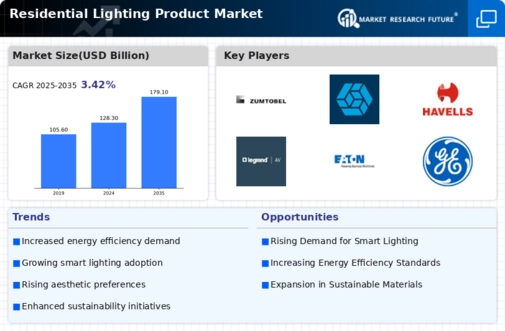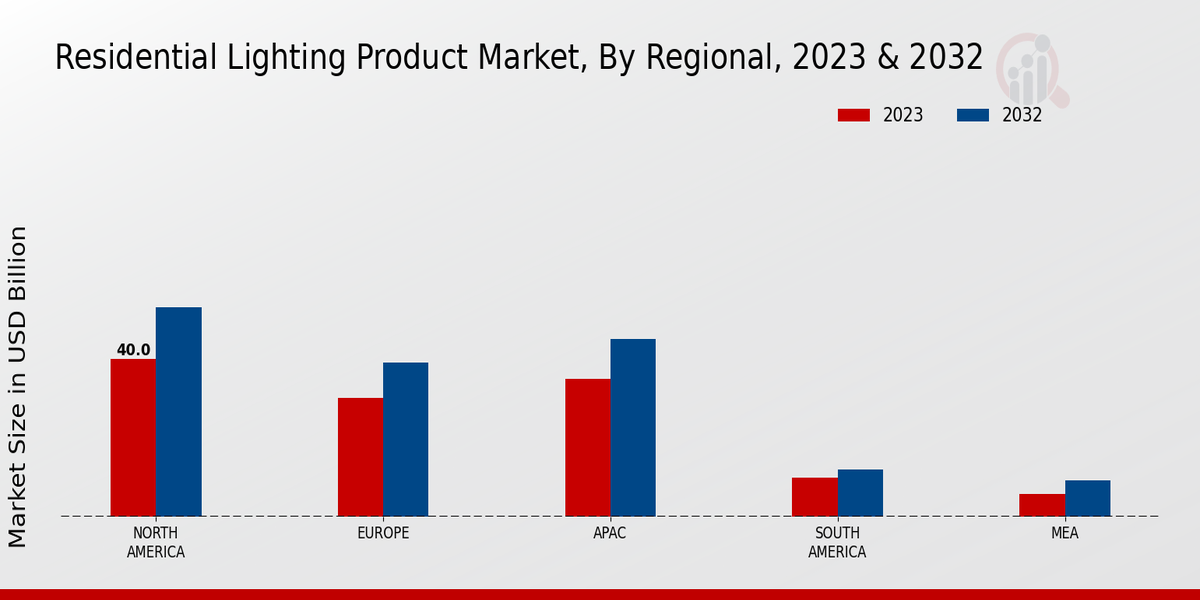Market Growth Projections
The Global Residential Lighting Product Market Industry is projected to experience steady growth over the next decade. With a current valuation of 128.3 USD Billion in 2024, the market is expected to reach 179.1 USD Billion by 2035, reflecting a compound annual growth rate (CAGR) of 3.08% from 2025 to 2035. This growth trajectory suggests a robust demand for innovative lighting solutions, driven by factors such as energy efficiency, technological advancements, and changing consumer preferences. The market's expansion indicates a positive outlook for stakeholders, including manufacturers, retailers, and consumers, as they navigate the evolving landscape of residential lighting.
Growing Demand for Energy Efficiency
The Global Residential Lighting Product Market Industry experiences a notable surge in demand for energy-efficient lighting solutions. As consumers increasingly prioritize sustainability, the adoption of LED technology has risen significantly. In 2024, the market is valued at 128.3 USD Billion, reflecting a shift towards products that reduce energy consumption and lower electricity bills. Governments worldwide are implementing regulations and incentives to promote energy-efficient lighting, further driving this trend. The emphasis on reducing carbon footprints aligns with global initiatives aimed at combating climate change, suggesting that energy efficiency will remain a pivotal driver in the residential lighting sector.
Government Initiatives and Regulations
Government initiatives and regulations play a pivotal role in shaping the Global Residential Lighting Product Market Industry. Many countries are implementing policies aimed at phasing out incandescent bulbs and promoting the use of energy-efficient alternatives. These regulations not only encourage manufacturers to innovate but also educate consumers about the benefits of modern lighting solutions. As governments push for sustainability and energy conservation, the market is likely to witness increased investment in research and development. This proactive approach indicates that regulatory frameworks will continue to drive the adoption of advanced lighting technologies, fostering growth in the residential lighting sector.
Rising Urbanization and Population Growth
Urbanization and population growth significantly influence the Global Residential Lighting Product Market Industry. As more individuals migrate to urban areas, the demand for residential lighting solutions increases correspondingly. This trend is particularly evident in developing regions, where rapid urban expansion creates a need for modern lighting infrastructure. The growing population, coupled with rising disposable incomes, suggests that consumers are more willing to invest in quality lighting products. By 2035, the market is projected to reach 179.1 USD Billion, indicating that urbanization will remain a key driver of growth in the residential lighting sector.
Technological Advancements in Lighting Solutions
Technological innovation plays a crucial role in shaping the Global Residential Lighting Product Market Industry. Advances in smart lighting technology, such as IoT integration and automation, are transforming how consumers interact with their lighting systems. These innovations allow for enhanced control, customization, and energy management, appealing to tech-savvy homeowners. As the market evolves, the introduction of features like voice control and app-based management is likely to attract a broader audience. This trend indicates that technological advancements will continue to be a driving force, fostering growth and expanding market reach in the coming years.
Increased Focus on Aesthetics and Interior Design
The Global Residential Lighting Product Market Industry is increasingly influenced by the growing emphasis on aesthetics and interior design. Homeowners are now more inclined to view lighting not merely as a functional element but as a vital component of their home decor. This shift has led to a rise in demand for decorative and designer lighting fixtures that enhance the ambiance of living spaces. Retailers are responding by offering a diverse range of stylish options, catering to various tastes and preferences. This trend suggests that the intersection of design and functionality will continue to propel market growth, as consumers seek to create visually appealing environments.
























